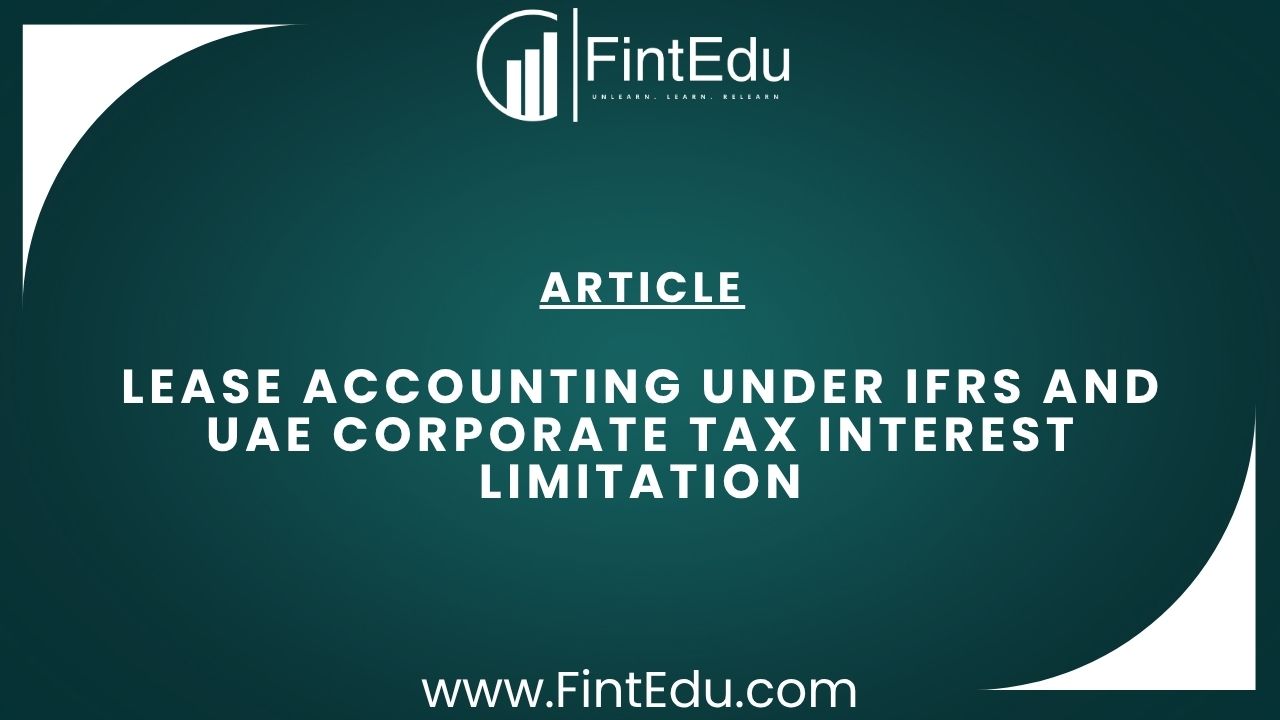IFRS 16 Treatment of Finance vs. Operating Leases
Lessee Accounting (IFRS 16): IFRS 16 uses a single model for lessees, eliminating the old finance/operating lease split. Except for short-term (≤12 months) or low-value asset leases (where an exemption is elected), a lessee must recognize a Right-of-Use (ROU) asset and a lease liability at the lease commencement.
The lease liability is measured at the present value of future lease payments, discounted typically at the lease’s implicit interest rate or the lessee’s incremental borrowing rate. Over the lease term, the liability increases as interest accrues and decreases as payments are made; the unwinding of the discount is recorded as interest expense (finance cost) in the profit and loss statement. This means that for virtually all leases longer than 12 months, IFRS 16 will report a finance (interest) cost each period, this holds true regardless of whether the lease would have been classified as “finance” or “operating” under older standards. The ROU asset is depreciated over the lease term (or useful life if shorter) and this depreciation is recorded separately from the interest. In summary, the lessee’s income statement will show depreciation of the ROU asset and interest expense on the lease liability as distinct components, instead of a single rent expense.
Example – Lessee:
-
A 5-year equipment lease requires annual payments of AED 100,000.
-
At 5% discount rate, the lessee records an ROU asset and lease liability of AED 432,940 at start.
-
Each year, the lessee records interest expense as the lease liability’s finance charge (AED 21,647 in year 1) and depreciation (AED 86,588 per year, based on asset value).
-
The lease payment (AED 100k) is split: AED 21,647 interest goes to P&L, and AED 78,353 reduces the liability.
Lessor Accounting (IFRS 16): IFRS 16 retains the finance vs. operating lease distinction for lessors. If a lease transfers substantially all risks and rewards (finance lease), the lessor derecognizes the asset and records a net investment in lease (receivable); the lessor’s income over the term comes from interest income on this receivable. In an operating lease, the lessor keeps the asset on its balance sheet (depreciating it) and recognizes rental income on a straight-line or systematic basis over the lease term – no separate interest income is recorded in the lessor’s P&L for an operating lease. Thus, under IFRS, a lessor’s finance lease will show interest income over time, whereas an operating lease will not isolate any finance charge (the entire payment is rental revenue).
Financial Statement Presentation: Lessees present interest on lease liabilities within finance costs in the income statement, separate from depreciation of ROU assets. This improves transparency by showing the financing cost of leases distinctly. On the balance sheet, ROU assets may be presented with property and equipment (with disclosure in notes), and lease liabilities are shown among financial liabilities or separately. In the cash flow statement, the interest portion of lease payments is typically classified under operating activities (as interest paid), while the principal portion is a financing cash outflow (repayment of lease liability), aligning with IFRS 16’s guidance. For lessors, finance lease receivables and interest income are presented similar to other financial assets/interest, and operating lease assets and rental income are presented like other fixed assets and revenue. Companies should disclose their lease accounting policies and provide notes on lease liabilities maturity, interest expense on leases, and expenses relating to short-term or low-value leases, as required by IFRS 16.
Finance Leases – Treatment and Interest Component
Under IFRS, a finance lease (or any lease recorded with a ROU asset and liability by the lessee) explicitly separates the finance cost. The periodic interest expense recorded on the lease liability is the “finance element” of those lease payments. From an accounting perspective, this finance charge reflects the cost of financing the right to use the asset. For the lessee, this interest expense is recorded in the books each period; for the lessor (in a finance lease arrangement), the interest income is recognized on the outstanding net investment.
UAE Corporate Tax – Interest Deduction Rule: The UAE Corporate Tax law treats the finance cost element of finance leases as interest for tax purposes. Article 5(1) of Ministerial Decision No. 126 of 2023 states that “the finance element of finance lease payments as documented in the accounts… shall be considered Interest for the purposes of the General Interest Deduction Limitation Rule”. In practice, this means no special adjustment is needed for finance leases when computing taxable income: the interest portion already recorded in the lessee’s profit and loss is taken to be “interest” in the tax computation. The same applies to lessors, any interest income from finance leases is treated as interest income under the interest limitation rules.
-
Deductibility: The interest expense from a finance lease will be pooled with other interest expenses for the General Interest Deduction Limitation Rule (GIDLR) calculation. As part of a taxpayer’s Net Interest Expenditure (NIE), it is subject to the 30% of EBITDA limit (if applicable) just like interest on bank loans. For example, if a lessee’s finance leases resulted in AED 500,000 of interest expense in 2024 (as per its IFRS accounts), that AED 500k is included in the total interest expense figure for interest limitation purposes. If the company also has interest income (say from deposits or a lessor’s finance lease receivable), those would offset to arrive at net interest.
-
Financial Reporting vs. Tax: Since IFRS already records the finance lease interest clearly, the taxable amount of “interest” from such leases in 2024 is essentially the same number shown in the financial statements.
Operating Leases – Treatment and Finance Element Computation
Under IFRS 16, the term “operating lease” is primarily relevant for lessors, since lessees generally bring all but short-term/low-value leases on balance sheet. However, it’s common to refer to leases that do not transfer substantially all risks and rewards as “operating leases.” Key considerations for such leases:
-
Lessee Accounting: If a lessee has a lease that is economically an operating lease, IFRS 16 still requires recognition of a lease liability and interest expense unless an exemption is applied. Thus, for most lessees, even leases without ownership transfer will produce an interest expense in the accounts (the “finance cost” of the lease liability unwinding) each period. Only when a lessee elects the practical expedient for short-term or low-value leases would the lease payments be expensed in full as operating rental cost with no separate interest in the accounts. In those exempt cases (and only those cases), IFRS financials show simply “lease expense” in operating costs and no ROU asset or interest.
-
Lessor Accounting: For a lessor, an operating lease means the lessor keeps the asset on its books and shows rental income in the P&L. There is no interest income recorded, because from the lessor’s perspective the arrangement is not treated as providing financing to the lessee but rather as providing the asset’s use as a service. The lessor’s entire lease payment is revenue, and the asset is depreciated over time. In sum, under accounting principles, there is no “finance element” recognized explicitly in an operating lease for either the lessee using IFRS 16 (who normally would have converted it to a finance-type accounting) or the lessor (who treats it as rental). The Ministerial Decision acknowledges this accounting reality but introduces a requirement to isolate an “economic” finance component for tax purposes.
UAE Corporate Tax – Finance Element of Operating Leases: Article 5(2) of MD 126 (2023) specifies that “the finance element of non-finance lease (operating lease) payments shall be considered as Interest for purposes of the interest limitation rule”. In simple terms, even if a lease is structured as an operating lease (no transfer of ownership), the UAE tax law wants the interest portion hidden within those rental payments to be identified and treated like interest. This ensures that financing costs cannot escape the interest limitation simply by being embedded in lease payments. Both expenditure and income related to that finance element are covered, so it applies to lessees (interest expense portion of rent) and lessors (interest income portion of rent) alike.
To comply with this rule, one must calculate the “finance element” of operating lease payments. The ministerial decision provides a methodology:
-
Total Finance Element: First, determine the total finance element over the entire lease term. This is defined as the total cost of the lease (i.e. sum of all lease payments over the term) minus the value of the leased asset at the start of the lease minus the expected value of the asset at the end of the lease. Essentially, this computes the total interest that would be paid over the lease term.
For example:
-
Lessee is leasing an asset worth AED 500,000 (value at commencement) and will return it at lease end (estimated residual value, say AED 50,000),
-
Total rentals over the term amount to AED 600,000, then the total finance element is AED 600k – 500k – 50k = AED 50,000.
-
This AED 50k represents the financing cost spread across the lease duration (the time value of money for using a 500k asset).
-
Allocate to Periods: Next, allocate this total finance element to individual lease payments or periods. The law indicates it should be proportional to the share of each payment in the total cost. In practice, the most accurate way is to derive the implied interest rate and create an amortization schedule for the lease (similar to how one would under IFRS 16). However, a proportional allocation can be done if needed. Using the above example (AED 50k total interest on AED 600k total payments), if payments are uniform annually, one might allocate roughly equal interest to each year, or better, calculate the implicit interest rate that yields AED 50k over the term and apply it. The FTA’s guidance (April 2025) suggests using the economic reality of the lease: if the lessee’s books (under IFRS) already recognized a finance charge (because a ROU asset was booked), that amount is the lease’s finance element for that period. If not (e.g., a lessor’s operating lease income), one should compute it externally. The FTA guide confirms that the lessor must compute a notional interest portion even though none is in their accounting records, “calculated proportionally based on the lease payments and total financing cost over the lease term.”
-
Include in Interest Expense/Income: Once the finance portion of each lease payment is determined, it is treated as interest in the tax computation. For lessees, that portion of the rental payment is added to other interest expenses. For lessors, that portion of rental income is added to interest income for netting. This does not necessarily change how the lease is booked in the financial statements (IFRS accounts remain as they are), but it’s an adjustment in the tax workpapers: effectively reclassifying part of rent expense as interest expense (or part of rent revenue as interest income) for tax purposes. The concept is that an operating lease contains an implicit loan from lessor to lessee (the lessor “finances” the use of the asset), and the finance element is the imputed interest on that loan. The Ministerial Decision creates a “fiction” for tax: even if “lease payments are pure rental income” under accounting, the lessor is required to treat (for example) AED 10,000 per year as interest income if that is the calculated finance element, to align with the policy intent of capturing time-value-of-money costs.
Interest Deduction Limitation Rule – Application to Leases in 2024
The UAE Corporate Tax’s General Interest Deduction Limitation Rule (GIDLR) limits the tax deductibility of net interest to prevent excessive interest stripping. In broad terms, a taxable person’s Net Interest Expenditure (NIE) (i.e. total interest expense minus interest income for the period) can be deducted in full only up to a certain threshold. Any net interest above that amount may be restricted. As of 2024, the rule is: if the net interest expense does not exceed AED 12 million (de minimis threshold) in the tax period, it’s fully deductible. If it exceeds AED 12 million, the business may deduct up to the higher of AED 12 million or 30% of adjusted taxable EBITDA (earnings before interest, tax, depreciation, amortization, as defined for tax). In effect, large net interest costs are capped at 30% of EBITDA, with a minimum safe harbor of 12 million. Any disallowed interest can be carried forward for up to 10 years to potentially deduct in future periods.
Lease Interest in the GIDLR Calculation: The finance element of both finance and operating leases must be included when computing the net interest expense. This means for tax year 2024, companies need to aggregate:
-
All traditional interest expense (e.g. on bank loans, bonds, etc.),
-
Plus the interest portion of finance lease payments (from lessee’s IFRS accounts),
-
Plus the interest portion of operating lease payments (as calculated per Article 5 for any leases where such a portion exists),
and then subtract any interest income (including, for instance, interest on deposits, interest income from finance leases to customers, and the imputed interest component of any operating lease income for lessors). The result is the net interest expense. If that net interest expense ≤ AED 12m, the limitation doesn’t apply and the full amount is deductible. If it exceeds AED 12m, the deductible amount is capped at 30% of the company’s adjusted EBITDA (or AED 12m, whichever is higher). Any amount beyond the cap is not deductible in 2024, but can be carried forward (subject to the 10-year limit) to be used in future years’ interest limitation calculations.
-
Importance of Identifying Lease Interest: It’s crucial for 2024 that companies properly identify the interest component in leases because it can materially impact the net interest calculation.
For example, a company with heavy use of leasing (e.g. airlines leasing aircraft, retailers leasing stores) will have significant lease finance costs. Under IFRS 16, their EBITDA might appear high (since rent is replaced by interest+depreciation, the depreciation is added back in EBITDA while interest is not), but the interest portion of leases could push their net interest well above 12 million. If they ignored the lease interest, they might mistakenly assume they are under the threshold. The UAE rules explicitly prevent this by capturing lease finance elements as interest.
Thus, taxpayers should ensure that for every lease in 2024, they have either taken the interest from their books (for finance/ROU leases) or computed the implied interest (for operating leases as needed) and included it in the interest tally.
-
Disclosure and Documentation: While financial statements may not separately show an “interest on operating leases” if the lessee used an exemption or if we look at lessor accounts, for tax compliance one must document the calculation of any such interest. The FTA’s Interest Deduction Limitation Guide (2025) provides illustrative examples of how to calculate and report the finance element for both finance and operating leases.
Companies should maintain working papers showing the lease-by-lease breakdown:
e.g. “Lease of asset, total payments, asset value, residual, and computed total finance element, of which amount allocated to 2024”.
This ensures that if audited, the basis for including (or excluding) certain amounts as interest is clear. In the tax return or supporting schedules, the finance elements of leases would typically be added to other interest in arriving at the NIE. Some firms may choose to add back the IFRS lease interest and deduct the cash lease payments (mirroring a more traditional tax treatment) for clarity, but ultimately the result should conform to including the correct interest amount as required by the law.
Booking and Disclosure in Financial Statements (Summary)
Recording Leases (Lessee): From an accounting entry perspective, IFRS 16 requires at inception:
Dr. ROU Asset, Cr. Lease Liability for the present value of lease payments.
Subsequently, at each payment: interest accrues on the lease liability (Dr. Interest Expense, Cr. Lease Liability) and the payment is made (Dr. Lease Liability, Cr. Bank/Cash), effectively splitting the rent into interest and principal. Separately, the ROU asset is depreciated (Dr. Depreciation Expense, Cr. Accumulated Depreciation) over time.
These journal entries are the same whether the lease is economically finance or operating in nature (except for short-term/low-value leases which would simply be Dr. Lease Expense, Cr. Cash for payments).
In the 2024 financials, a lessee would disclose total interest expense on lease liabilities as part of finance costs (often aggregated with other interest in the income statement, but sometimes shown in notes) and the depreciation of ROU assets in the depreciation line. The notes to the financials typically detail the lease liabilities (e.g. maturity analysis of future payments) and may explicitly state the finance cost on leases for the year.
Recording Leases (Lessor): For a finance lease,
(a) the lessor will record interest income over the lease term (Dr. Lease Receivable, Cr. Interest Income for accruing interest; Dr. Cash, Cr. Lease Receivable for payments). In an operating lease, the lessor simply records rental income (Dr. Receivable/Cash, Cr. Rental Income) and depreciation on the underlying asset (Dr. Depreciation, Cr. Accumulated Depreciation).
(b) The financial statements of a lessor in 2024 would show lease income (with finance lease interest often included in finance income, and operating lease income as part of revenue) and depreciation of leased assets (for operating leases) on the income statement. There would be no “interest income from operating leases” disclosed in the accounts, that notion exists only for tax. However, the lessor should be prepared to identify a portion of that rental income as interest for tax purposes, as discussed.
Link between FS and Tax for Leases: The tax treatment does not require changing the financial statements; it only requires an adjustment in the tax computation.
For instance, if a lessee had an:
(a) operating lease and elected the IFRS 16 short-term exemption, the 2024 P&L shows the full lease payment (say AED 100k) as an expense.
(b) For tax, the company must calculate that, out of this 100k, perhaps AED 8k is a finance cost, they would then treat AED 8k as “interest expense” in the GIDLR calculation and the remaining AED 92k as normal deductible operating expense.
(c) This could be done by adding AED 8k to interest expense and simultaneously ensuring the full 100k is still deducted (either by not adjusting it at all since it’s fully deducted as business expense and just noting that 8k of it has been considered in the interest limitation test).
(d) In contrast, if IFRS 16 was applied (lessee recognized a lease liability), the 100k payment was already split in the accounts (interest vs depreciation), so the financials naturally provided (for example) 8k interest and 92k depreciation, the tax return would simply pick up the 8k as part of interest. Companies should disclose any significant judgments in determining the lease discount rates or residual values (which affect the finance element) in their financials as per IFRS, but those are accounting disclosures.
In summary, for UAE corporate tax purposes in 2024, the finance (interest) portion of lease payments – for both finance leases and operating leases, must be identified and included in the interest limitation computation. Under IFRS, finance leases (and virtually all long-term leases for lessees) already segregate that interest cost in the books. For any lease where IFRS does not separately show interest (e.g. a lessor’s operating lease or a lessee’s short-term lease), taxpayers should calculate the interest portion following the prescribed method. The amount of interest to consider for the GIDLR is the amount accruing in the relevant period (e.g. the interest amount for 2024 lease payments). By doing this, one ensures compliance with MD 126 and accurately applies the 30% EBITDA interest cap if applicable. Proper accounting for leases under IFRS and careful tax analysis go hand in hand: IFRS numbers provide the basis, and the tax law clarifies that the economic interest in all leases counts toward your interest deduction limit.
Disclaimer: Content posted is for informational and knowledge sharing purposes only, and is not intended to be a substitute for professional advice related to tax, finance or accounting. The view/interpretation of the publisher is based on the available Law, guidelines and information. Each reader should take due professional care before you act after reading the contents of that article/post. No warranty whatsoever is made that any of the articles are accurate and is not intended to provide, and should not be relied on for tax or accounting advice.Contributor
Related Posts

Company service providers play a critical role in shaping how businesses are formed, managed and mai...
Read More
The UAE’s tax framework is set for further evolution in 2026, with new VAT amendments, excise tax ...
Read More
Accountants in the UAE are deeply involved in the financial lifecycle of businesses. From structurin...
Read More